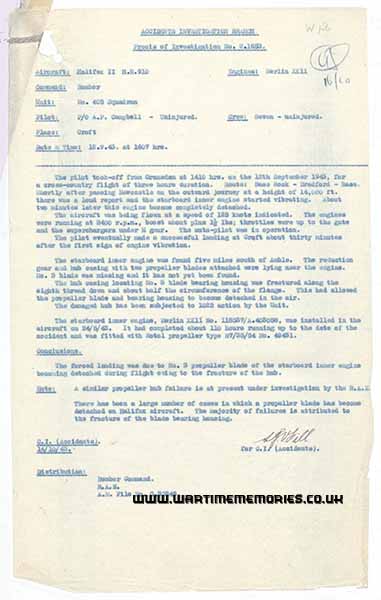A. P. Campbell
Royal Air Force 405 Sqd.
Accident Investigation Branch; Precis of Investigation No. W.1653 Halifax II H.R.910, Merlin XXII, Bomber Command, No. 405 Squadron Pilot: P./O. A.P. Campbell – Uninjured, crew of seven – Uninjured at Croft 12.9.43 at 1607 hrs.
The pilot A.P Campbell, took off from Gransden at 1410 hrs. on the 12th September 1943, for a cross-country flight of three hours duration. Route: Bass Rock – Bradford – Base. Shortly after passing Newcastle on ther outward journey at a height of 14,000 ft. there was a loud report and the starboard inner engine started vibrating. About two minutes later, this engine became completely detached.
The aircraft was being flown at a speed of 125 knots indicated. The engines were running at 2400 r.p.m., boost about plus 1½ lbs; throttles were up to the gate and the superchargers under M gear. The auto-pilot was in operation. The pilot eventually made a successful landing at Croft about thirty minutes after the first sign of engine vibration. The starboard inner engine was found five miles south of Amble. The reduction gear and hub casing with two propeller blades attached were lying near the engine. No. 3 blade was missing and it has not yet been found. The hub casing locating No. 3 blade bearing housing was fractured along the eighth thread down and about half the circumference of the flange. This had allowed the propeller blade and bearing housing to become detached in the air. The damaged hub has been subjected to 1022 action by the Unit.
The starboard inner engine, Merlin XXII No. 118537/A.403058, was installed in the aircraft on 24/5/43. It had completed about 110 hours running up to the date of the accident and was fitted with Rotol propeller type R7/35/54 No. 49431.
Conclusions: The forced landing was due to No. 3 propeller blade of the starboard inner engine becoming detached during flight owing to the fracture of the hub. Note: A similar propeller hub failure is at present under investigation by the R.A.E. There has been a large number of cases in which a propeller blade has become detached on Halifax aircraft. The majority of failures is attributed to the fracture of the blade bearing housing.
C.I. (Accidents). Illegible signature 14/10/43. for C.I. (Accidents).
Distribution: Bomber Command. R.A.E. A.M. File No. G.33249.
